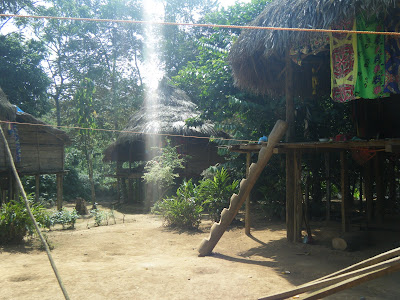We just happened to be in Panama City during carnival, a four day non-stop party. The whole country comes to a standstill to celebrate - and oh how they celebrate!
 Our apartment was eight blocks from the center of the activities. From 10am until the wee hours we were part of the experience - live music, fireworks and lots of revelry.
Our apartment was eight blocks from the center of the activities. From 10am until the wee hours we were part of the experience - live music, fireworks and lots of revelry.
The floats were quite spectacular.
 Queen of the Carnival.
Queen of the Carnival.
We set off for a day of adventure from the urban jungle to the real thing. We had a wonderful guide who took us for an hour long ride in a genuine dug out canoe, across the Gutan Lake, and up the Chagras River, to visit an Embera Indian village.
There were about 100 people in this particular village, living much as they did since the Spanish explorer, Vasco Nunez de Balboa, first set foot in Panama in the early 1500's.
 The children greeted us with music. There is a strong sense of community among the villagers, and the children have a deep respect for their elders.
The children greeted us with music. There is a strong sense of community among the villagers, and the children have a deep respect for their elders. The women entertained us with the "Flower Dance". This particular village sees very few tourists and they were extremely gracious and hospitable.
The women entertained us with the "Flower Dance". This particular village sees very few tourists and they were extremely gracious and hospitable. The women prepared a wonderful lunch of fresh fruit, fish and plantains served in a banana leaf - it was delicious!
The women prepared a wonderful lunch of fresh fruit, fish and plantains served in a banana leaf - it was delicious! Happy Embera baby. The villagers decorate their bodies with a natural fruit dye called Jagua, which acts as an insect repellent and protects their skin from the sun.
Happy Embera baby. The villagers decorate their bodies with a natural fruit dye called Jagua, which acts as an insect repellent and protects their skin from the sun. The Embera are skilled wood carvers and basket weavers. We bought this beautiful basket from Aniela, who was taught by her mother how to harvest and dye the materials from plants found in the jungle. The designs are never sketched, rather they evolve as the pieces are woven and carved.
The Embera are skilled wood carvers and basket weavers. We bought this beautiful basket from Aniela, who was taught by her mother how to harvest and dye the materials from plants found in the jungle. The designs are never sketched, rather they evolve as the pieces are woven and carved. The village Shaman took us on a tour of his "pharmacy" identifying plants and their medicinal uses.
The village Shaman took us on a tour of his "pharmacy" identifying plants and their medicinal uses.







No comments:
Post a Comment